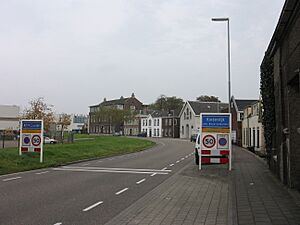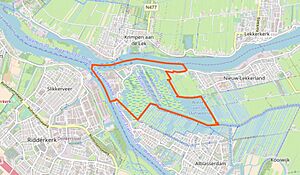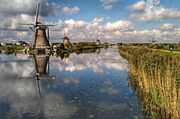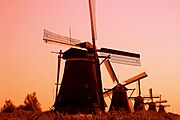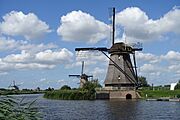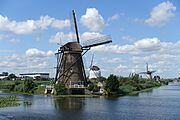Kinderdijk facts for kids
Quick facts for kids
Kinderdijk
|
|
|---|---|
|
Village
|
|

Windmills at Kinderdijk
|
|
| Country | Netherlands |
| Province | South Holland |
| Municipality | Molenlanden |
| Population
(1 January 2021)
|
|
| • Total | 800 |
Kinderdijk is a small village in the Netherlands. It's located in the province of South Holland, about 15 kilometers (9 miles) east of Rotterdam.
This village is famous for its 19 old windmills. These windmills were built around 1740. They helped pump water out of the low-lying land called a polder. It's the biggest group of old windmills in the Netherlands. People from all over the world visit Kinderdijk. In 1997, it became a UNESCO World Heritage Site. This means it's a very special place that needs to be protected.
Contents
What's in a Name? The Story of Kinderdijk
The name Kinderdijk means "Children dike" in Dutch. There's a famous old story about how the village got its name.
In 1421, a huge flood called the Saint Elizabeth flood happened. Much of the land was covered in water. But the area where Kinderdijk is now stayed dry.
The story says that after the storm, a villager went to check the dike. They saw a wooden cradle floating on the water. As it came closer, they saw something moving inside.
When they looked closer, they found a cat! The cat was jumping back and forth. It was trying to keep the cradle balanced so water wouldn't get in.
Finally, the cradle floated close enough to the dike. A bystander picked it up. Inside, a baby was sleeping peacefully, completely dry. The cat had saved the baby! This amazing story is often called "The Cat and the Cradle."
Why Windmills Were Built in Kinderdijk
For hundreds of years, the land around Kinderdijk had problems with water. This area is a polder, which means it's land that is below sea level. In the 1200s, people dug large canals to drain the extra water.
But the drained soil kept sinking lower. At the same time, the river levels rose because of sand building up. After a few centuries, they needed a new way to keep the polders dry.
So, people decided to build windmills. These windmills could pump water from the low polder into a higher storage area. From there, other windmills could pump the water into the river when its level was low.
Today, some of the old windmills still work. But most of the water is now moved by two modern diesel pumping stations. These stations help keep the land dry and safe from floods.
A Special World Heritage Site
Kinderdijk became a UNESCO World Heritage Site in 1997. It's recognized as a unique and important place. The village shows how people in the Netherlands have managed water for centuries. The 19 windmills are a beautiful example of 18th-century engineering and a key part of Dutch history.
Image gallery
See also
 In Spanish: Kinderdijk para niños
In Spanish: Kinderdijk para niños


